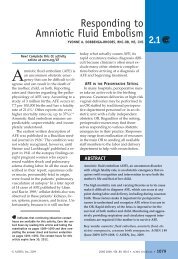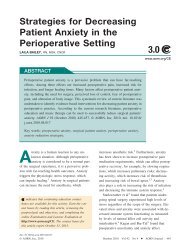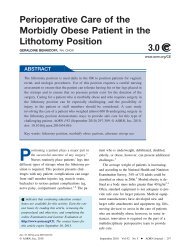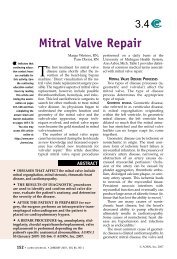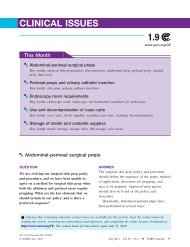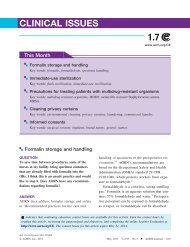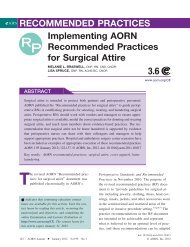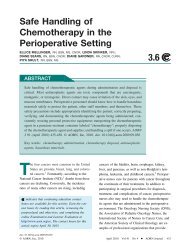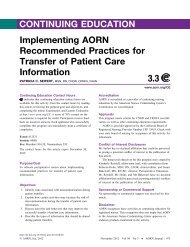Hand-Off Communication: A Requisite for Perioperative ... - AORN
Hand-Off Communication: A Requisite for Perioperative ... - AORN
Hand-Off Communication: A Requisite for Perioperative ... - AORN
You also want an ePaper? Increase the reach of your titles
YUMPU automatically turns print PDFs into web optimized ePapers that Google loves.
Amato-Vealey — Barba — Vealey NOVEMBER 2008, VOL 88, NO 5HAND-OFF COMMUNICATION BETWEEN THE HEALTH CAREFACILITY’S SCHEDULING DEPARTMENT AND THE PREOPERATIVEAREA. One of the first responsibilities of thepreoperative nurse is to obtain the surgeryschedule. The preoperative nurse then ensuresthat the scheduled procedure is consistentwith the patient’s understanding of theprocedure as well as the in<strong>for</strong>med consent,and that both are consistent with the patient’sdiagnosis. The nurse also ensures that all requireddocuments are in place, including thehistory and physical examination (H&P),blood work results, and any other diagnostictest results required <strong>for</strong> surgery. The nurse ensuresthat the surgeon has per<strong>for</strong>med an H&Pupdate be<strong>for</strong>e surgery.The Joint Commission’s Universal Protocol TMhas become a guiding principle <strong>for</strong> all perioperativeteam members and should be appliedto or adapted <strong>for</strong> all operative and other invasiveprocedures. 9 The Universal Protocol isnow included in the overall 2009 Hospital NationalPatient Safety Goals document. 5 Thesurgical verification process must include thefollowing essential elements:• active communication among all membersof the surgical team;• involvement of the patient or a legally designatedrepresentative in the process; and• a requirement <strong>for</strong> site marking that focuseson surgical procedures involving laterality(ie, right/left distinction), multiple structures(eg, fingers, toes), or multiple levels(eg, spine). 9Verification of the correct person, correct site,and correct procedure occurs at the followingtimes including ...anytimetheresponsibility<strong>for</strong> care of the patient is transferred to anothermember of the procedural care team,(including the anesthesia providers) at thetime of, and during, the procedure. 9The patient’s family members may be distractorsin the surgical verification process becauseof the stress they are experiencing fromtheir loved one’s impending surgery. The preoperativenurse should endeavor to involve thepatient’s family members in the verificationprocess at every opportunity to ensure that theyare fully knowledgeable of the process and thecorrect surgical procedure.HAND-OFF COMMUNICATION BETWEEN THE PREOPERATIVEAREA AND THE INTRAOPERATIVE AREA. <strong>Hand</strong>-off communicationimproves patient outcomes when allparticipants take active part in the process. 10 Inthe past, the hand-off communication betweenthe preoperative and intraoperative areassometimes was a short, terse statement or noreport at all. Implementation of a standardizedguide during hand-off communication can increaseefficiency and patient safety and reduceunnecessary redundancy while encouragingbuilt-in redundancy of vital facts. Table 1 outlinesthe SBAR elements of the optimal preoperativeto intraoperative hand-off communication.This transition of care summarizes criticalpatient in<strong>for</strong>mation such as• verifying the correct patient and surgicalprocedure,• reviewing required documents,• discussing patient safety concerns,• assessing preoperative vital signs and painlevel,• identifying cultural implications and theneed <strong>for</strong> family presence, and• verifying that all components of the surgicalprocess have been followed correctly.This hand-off communication serves as abaseline <strong>for</strong> future clinical transfers and ensuresthat patients are safe, secure, and com<strong>for</strong>tableas they are brought to the OR suite.All subsequent actions are based on thishand-off communication.Another component of the Universal Protocolis the surgical time out. 11,12 Be<strong>for</strong>e startingany operative or invasive procedure, a final“time out” verification should be conducted toconfirm the correct patient, procedure, and site.This time out should include ensuring that allrelevant documentation, related in<strong>for</strong>mation,and necessary equipment are available. Althoughthe surgical time out is initiated by adesignated member of the surgical team, all immediatemembers of the surgical team mustparticipate in the time out, during which allother activities are suspended as much as possiblewithout compromising patient safety. Theprocedure is not started until all questions andconcerns have been addressed satisfactorily.<strong>AORN</strong> JOURNAL • 765



